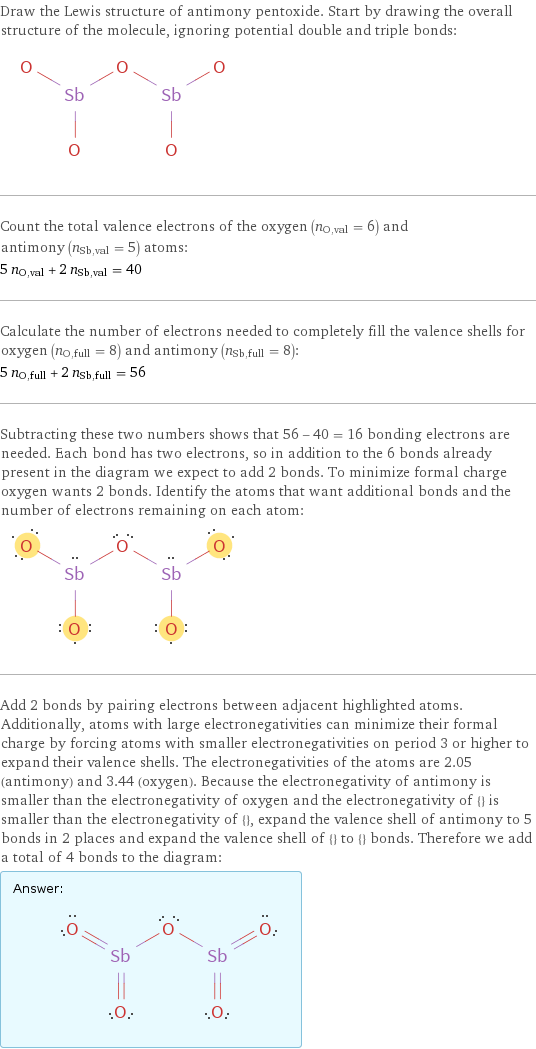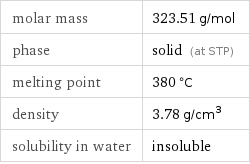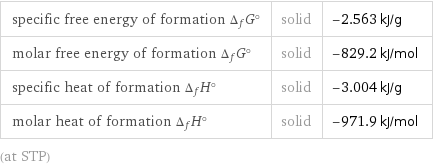Input interpretation

antimony pentoxide
Chemical names and formulas

formula | Sb_2O_5 Hill formula | O_5Sb_2 name | antimony pentoxide alternate names | antimonic oxide | antimony(V) oxide | antinomy(V) pentaoxide mass fractions | O (oxygen) 24.7% | Sb (antimony) 75.3%
Lewis structure

Draw the Lewis structure of antimony pentoxide. Start by drawing the overall structure of the molecule, ignoring potential double and triple bonds: Count the total valence electrons of the oxygen (n_O, val = 6) and antimony (n_Sb, val = 5) atoms: 5 n_O, val + 2 n_Sb, val = 40 Calculate the number of electrons needed to completely fill the valence shells for oxygen (n_O, full = 8) and antimony (n_Sb, full = 8): 5 n_O, full + 2 n_Sb, full = 56 Subtracting these two numbers shows that 56 - 40 = 16 bonding electrons are needed. Each bond has two electrons, so in addition to the 6 bonds already present in the diagram we expect to add 2 bonds. To minimize formal charge oxygen wants 2 bonds. Identify the atoms that want additional bonds and the number of electrons remaining on each atom: Add 2 bonds by pairing electrons between adjacent highlighted atoms. Additionally, atoms with large electronegativities can minimize their formal charge by forcing atoms with smaller electronegativities on period 3 or higher to expand their valence shells. The electronegativities of the atoms are 2.05 (antimony) and 3.44 (oxygen). Because the electronegativity of antimony is smaller than the electronegativity of oxygen and the electronegativity of {} is smaller than the electronegativity of {}, expand the valence shell of antimony to 5 bonds in 2 places and expand the valence shell of {} to {} bonds. Therefore we add a total of 4 bonds to the diagram: Answer: | |
Basic properties

molar mass | 323.51 g/mol phase | solid (at STP) melting point | 380 °C density | 3.78 g/cm^3 solubility in water | insoluble
Units

Solid properties (at STP)

density | 3.78 g/cm^3
Units

Thermodynamic properties

specific free energy of formation Δ_fG° | solid | -2.563 kJ/g molar free energy of formation Δ_fG° | solid | -829.2 kJ/mol specific heat of formation Δ_fH° | solid | -3.004 kJ/g molar heat of formation Δ_fH° | solid | -971.9 kJ/mol (at STP)
Chemical identifiers
O[Sb](=O)=O InChI identifier | InChI=1/5O.2Sb/rO5Sb2/c1-6(2)5-7(3)4 RTECS number | CC6300000 MDL number | MFCD00011216](../image_source/0fcbb462fd3db8d6e346e56a9066d24b.png)
CAS number | 1314-60-9 PubChem CID number | 14813 PubChem SID number | 24855500 SMILES identifier | O=[Sb](=O)O[Sb](=O)=O InChI identifier | InChI=1/5O.2Sb/rO5Sb2/c1-6(2)5-7(3)4 RTECS number | CC6300000 MDL number | MFCD00011216
Toxicity properties

RTECS classes | other